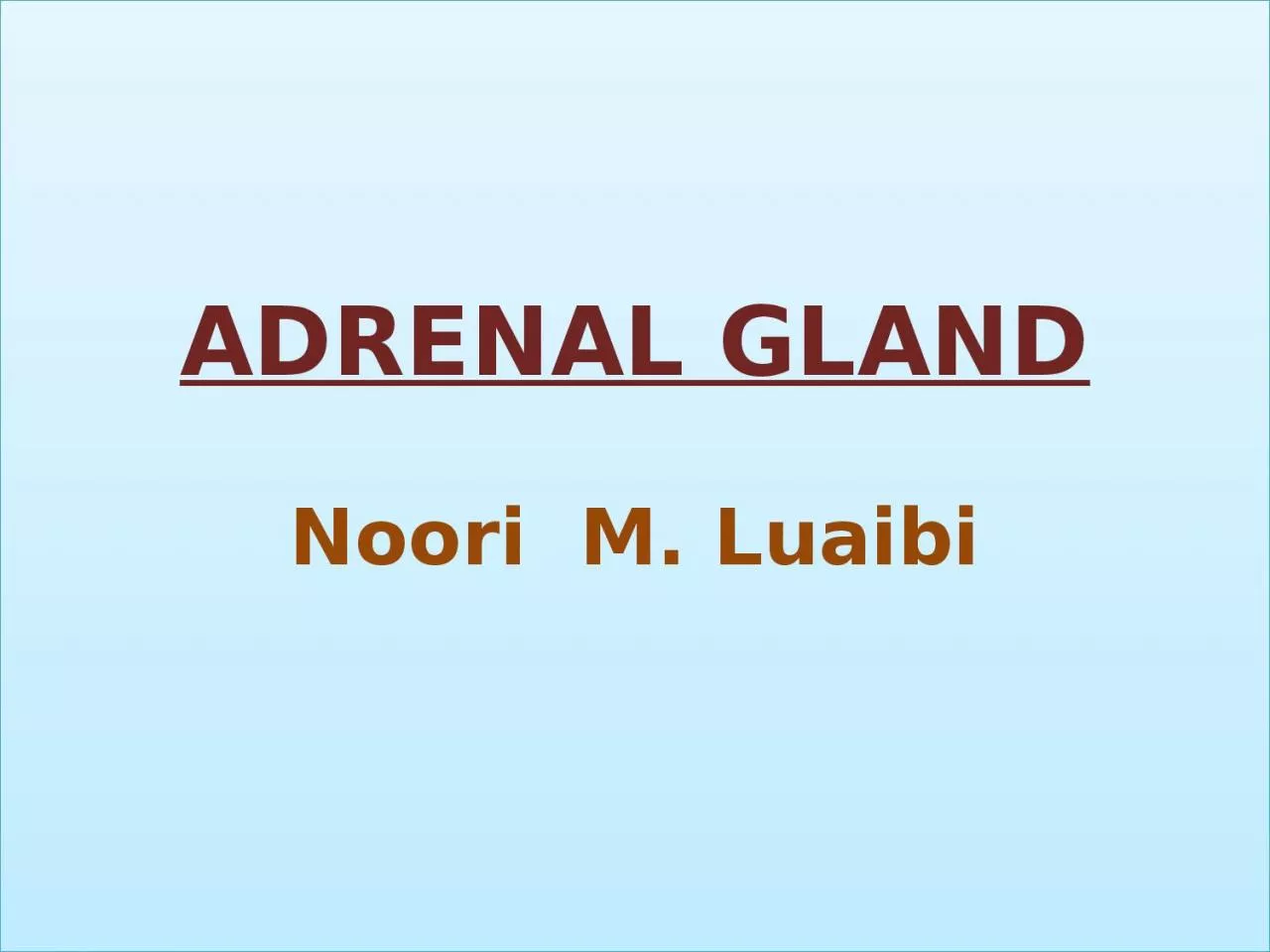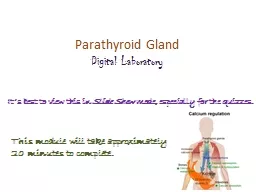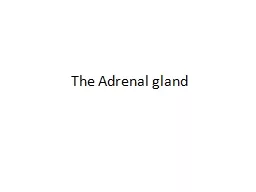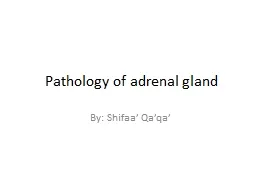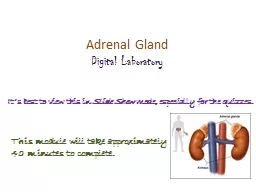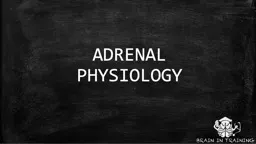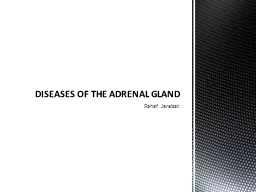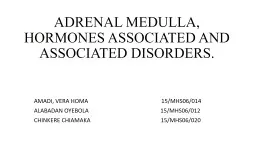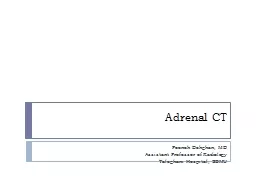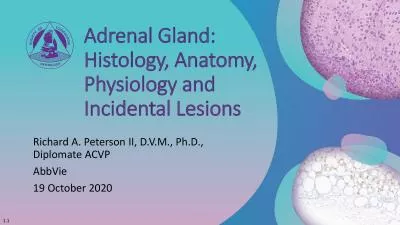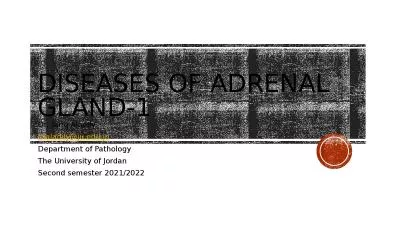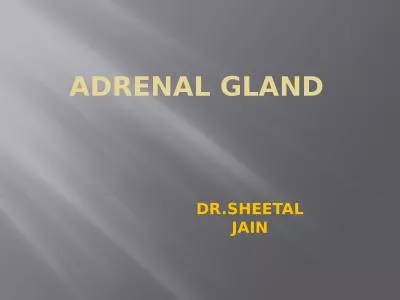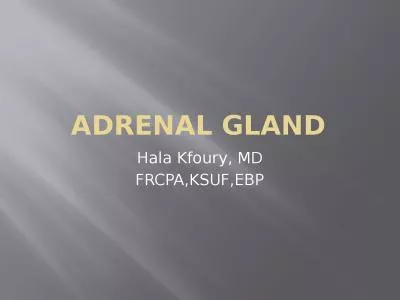PPT-Adrenal gland Noori M.
Author : eliza | Published Date : 2022-06-15
Luaibi Adrenocortical Hormones The two adrenal glands each of which weighs about 4 grams lie at the superior poles of the two kidneys As shown in Figure 771
Presentation Embed Code
Download Presentation
Download Presentation The PPT/PDF document "Adrenal gland Noori M." is the property of its rightful owner. Permission is granted to download and print the materials on this website for personal, non-commercial use only, and to display it on your personal computer provided you do not modify the materials and that you retain all copyright notices contained in the materials. By downloading content from our website, you accept the terms of this agreement.
Adrenal gland Noori M.: Transcript
Luaibi Adrenocortical Hormones The two adrenal glands each of which weighs about 4 grams lie at the superior poles of the two kidneys As shown in Figure 771 each gland is composed of two distinct parts the . Digital Laboratory. It’s best to view this in . Slide Show . mode, especially for the quizzes.. This module will take approximately 40 minutes to complete.. After completing this exercise, you should be able to:. Digital Laboratory. It’s best to view this in . Slide Show . mode, especially for the quizzes.. This module will take approximately 20 minutes to complete.. After completing this exercise, you should be able to:. . Hyperfunction. (. Hyperadrenalism. ). 1. . Hypercortisolism. (Cushing Syndrome) . - In clinical practice, most cases are caused by the administration of exogenous . glucocorticoids. (Iatrogenic). By: . Shifaa. ’ . Qa’qa. ’. adrenal glands:. cortex . medulla. ADRENOCORTICAL. HYPERFUNCTION. (HYPERADRENALISM). Cushing syndrome. hyperaldosteronism. . adrenogenital. or . virilizing. . syndromes. Diseases of the Adrenal gland Adrenal insufficiency Cushing disease vs syndrome Pheochromocytoma Hyperaldostronism What are the layers of the adrenal gland ?? And what does each layer produce ?? It’s best to view this in . Slide Show . mode, especially for the quizzes.. This module will take approximately 40 minutes to complete.. After completing this exercise, you should be able to:. . identify, at the light microscope level, each of the following:. The adrenal gland is one of the body’s main endocrine glands.. It consists of a . cortex . and. medulla.. The cortex has . three layers . which each secrete a . different. class of steroid.. The . Pyramidal in shape. 3- 5 cm in height , 3 cm in width , less than 1 cm . thicK. , Mass . 3.5 - 5 g . The . adrenal gland is divided into 2 areas, the cortex and medulla. . The cortex is divided into 3 areas: GFR. GROUP ONE. AMADI. , VERA HOMA (PRESENTER) 15/MHS06/014. ALABADAN OYEBOLA 15/MHS06/012. CHINKERE CHIAMAKA 15/MHS06/020. , MD. Assistant Professor of Radiology. Taleghani. Hospital, SBMU. Adrenal CT. Morphology and anatomy in CT. Lesion . characterisation. Location & Boundaries. Schematic presentation of the adrenal in CT. Histology, Anatomy, Physiology and Incidental Lesions Richard A. Peterson II, D.V.M., Ph.D., Diplomate ACVPAbbVie19 October 2020 1.1 The Adrenal Gland Most common endocrine organ associated with che Dr. Tariq Aladily. tnaladily@ju.edu.jo. Department of Pathology. The University of Jordan. Second semester 2021/2022. Hypercortisolism . AKA Cushing syndrome. Can be exogenous (iatrogenic) or endogenous (less common). ADRENAL GLAND. Adrenal Gland Location. The . Adrenal Glands are found on top of each kidney. Even the name “Adrenal” directly refers to their location: (. Latin: ad– “near” and . renes. – “kidneys.. , MD. FRCPA,KSUF,EBP. Adrenal Glands. The . adrenal glands: paired endocrine organs: cortex and medulla: 4 . Three layers in the cortex:. Zonaglomerulosa. Zonareticularis. abuts the medulla. . Intervening is the broad .
Download Document
Here is the link to download the presentation.
"Adrenal gland Noori M."The content belongs to its owner. You may download and print it for personal use, without modification, and keep all copyright notices. By downloading, you agree to these terms.
Related Documents

